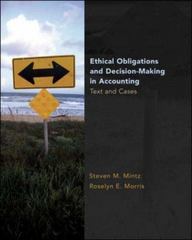Question
Question 1 State whether each of the following statements is True or False with explanation: a. When as a business has an accumulated depreciation account
Question 1
State whether each of the following statements is True or False with explanation:
a. When as a business has an accumulated depreciation account of RM4,000 for a particular non-current assets, it means the business has accumulated, or set aside this amount of cash for replacement later.
b. Depreciation is the fall in value of non-current assets.
c. The straight line method is the depreciation method where decreasing amounts of depreciation are being charged to the Statement of Profit or Loss over the years.
d. Net book value is the estimated value of non-current assets after deducting accumulated depreciation.
e. Capital expenditure is incurred when a business spends money to buy or increase the value of non-current asset.
Question 2
Bryan operates a candy factory in Rawang. The machines in his factory are purchased overseas. On 1 Jan 2012, he purchased a machine from Korea costing RM120,000. The machine was delivered to Malaysia on freight. The transportation cost of RM3,000 and freight insurance of RM1,200 was borne by Bryan. When the machine landed in Malaysia, Bryan paid custom duty of RM3,000.Bryan hired an engineer to install the machine within the factory. The engineer told Bryan that in the event Bryan wishes to dismantle the machine in the future, it would cost him RM700. After the installation was completed, the engineer billed him at RM1000.Bryan plans to use the machine for 6 years. Every year, the machine would be maintained at a cost of RM350. In year 7, the machine will be dismantled and sold off as scrap for RM5,000.For every of his assets, Bryan adopts the policy to make full year depreciation in the year of purchase.
Required:
(a) Calculate the cost of the machine.
(b) Compute the annual depreciation for the years ended 31 Dec 2012, 2013, 2014, 2015, 2016 and 2017 using the following depreciation basis:
(i) straight line
(ii) reducing balance basis at the rate of 42% per annum
(c) With your answer in (b) (ii) above, prepare for the years ended 31 Dec 2014, 2015 and 2016:
(i) Machinery account
(ii) Depreciation account
(iii) Accumulated depreciation account
(iv) Statement of Profit or Loss (extract)
(v) Statement of Financial Position (extract)
(d) Show the journal entries to record the depreciation charge for the year ended 31 Dec 2012 and 2013 using the reducing balance method.
Question 3
A car cost RM96,000. It will be kept for 3 years, and then sold for an estimated value of RM24,000.
Required:
Calculate depreciation for each year using:
(c) Straight line method
(d) Reducing balance method, with depreciation rate of 37%
Question 4
Genesis Trading currently has a problem in finalizing the depreciation charges for the non-current assets. The bookkeeper has provided the
following information as at 1 Jan 2016:

Step by Step Solution
There are 3 Steps involved in it
Step: 1

Get Instant Access to Expert-Tailored Solutions
See step-by-step solutions with expert insights and AI powered tools for academic success
Step: 2

Step: 3

Ace Your Homework with AI
Get the answers you need in no time with our AI-driven, step-by-step assistance
Get Started


